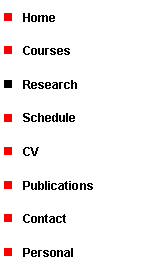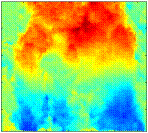


|
Different leech species have different behavioral responses to physical stimulation of the skin. I am trying to understand how the interactions between highly conserved neurons have changed to produce different behaviors. |
|
Touch (T), pressure (P), and nociceptive (N) cells all are found in different species of leech. T cells respond to light stimulation, P cells respond to stronger stimulation, and N cells begin to respond when the skin is damaged. I am interested in how the sensitivity and the receptive fields of each cell type differs between species. |
|
● Interactions between mechanosensory cells |
|
Research |

|
Assistant Professor of Biology |
|
Michael J. Baltzley |
|
Leech Projects |
|
Figure 1: Motion analysis of the body wall of Hirudo verbana in response to stimulation of the body wall. The asterisk indicates where the body wall was physically stimulated. Red indicates movement downward, blue indicates movement upward. |
|
● Receptive properties of mechanosensory neurons |


|
* |
|
Figure 2: Response of T cells in two different species of leech when 1 mm2 of the body wall was with a force of 100 mN for 500 msec. |
|
Gastropod Projects |
|
● Scaling effects of foot size on crawling speed |
|
Most snails and slugs crawl using muscular waves, but a subset of gastropods crawl using mucociliary locomotion. Crawling speed increases with foot size in slugs and snails that use muscular waves to crawl, and while it has been hypothesized that crawling speed should not increase with foot size in mucociliary crawlers, this idea has not been well studied. My students are measuring the relationship between foot size and crawling speed in various aquatic and terrestrial snails to test this hypothesis. |
|
Current Students |
|
Spicie Davis Anusha Hoda Taylor James Joel Yost Eli Zachary |
|
Fly Projects |
|
● Identifying GABAergic cells in the central ganglia of gastropods |
|
While the central nervous systems of closely related species are generally conserved, there are many examples of variability in the size, number, and location of homologous neurons. We are examining the nervous system of Helix aspersa to investigate whether there is similar intraspecific variability between different populations of the same species. |
|
● Selectively breeding of fruit flies with orientation preferences |
|
Dr. Latham and I are collaborating with 3 students to create strains of Drosophila melanogaster with specific orientation preferences. Our students created a sequential Y-maze that is used to isolate individual flies based on their directional choices. The flies are being run through the maze and then selectively bred for 15 generations. |